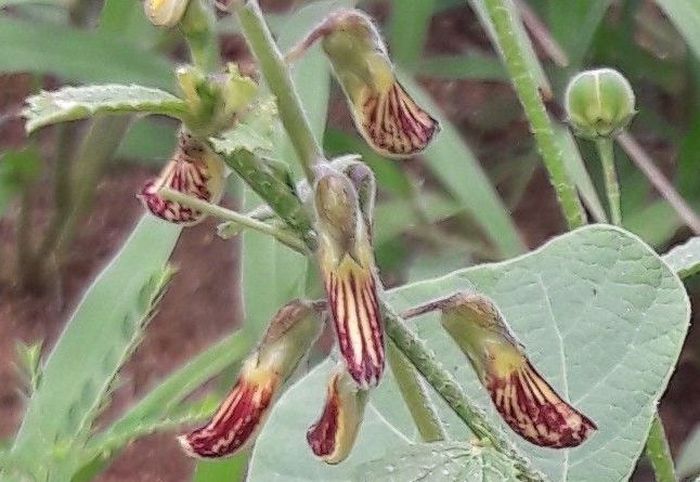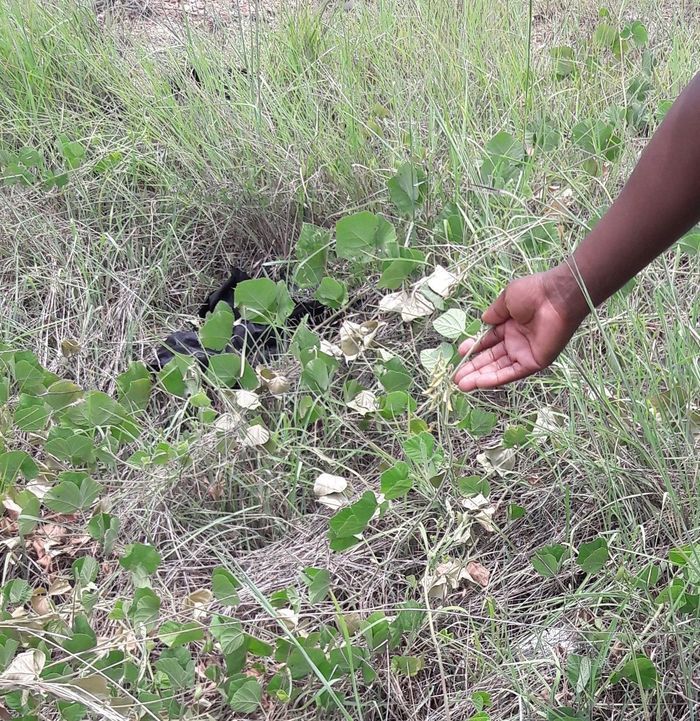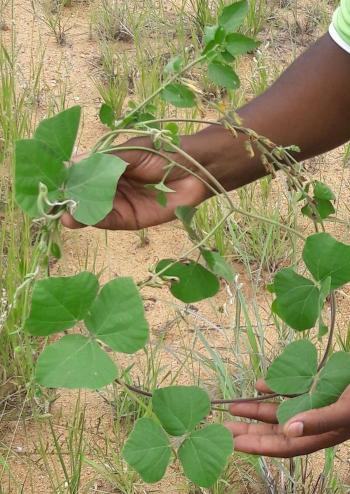Rhynchosia sublobata
Rhynchosia sublobata (Schumach. & Thonn.) Meikle.
Family: Fabaceae
Common names: none
Introduction
A yellow-flowered, indigenous African herb, with twining stems and velvety with silvery grey hairs. Its roots and leaves are used in traditional medicine to treat general stomach problems, gall bladder in children, chest illnesses, pneumonia, rheumatism and scabies.

Description
Description
Rhynchosia sublobata is a perennial climbing herb, up to 2 m long. The stems are twining, pubescent, growing from a woody rootstock. The leaves are trifoliolate, elliptic to ovate, rounded at both ends, often slightly lobed at the base; the terminal leaflet, rhomboid, 18–80 × 17–80 mm, thinly pubescent and gland-dotted beneath; the petiole 15–70 mm long; stipules 5–7 × 2 mm, narrow and covered with hairs.

The inflorescences in axillary racemes, 60–200 mm long, sticky, glabrescent or pubescent. The flowers are 9–12 mm long, yellow or cream-coloured with dark reddish or maroonish stripes. The fruit is an oblong-falcate pod, 20–40 × 6–13 mm, inflated and covered with a thin pubescence. Flowering time is midsummer (January–December).
Conservation Status
Status
According to Raimondo et al. (2009), Rhynchosia sublobata is Red Listed as Least Concern (LC), as evaluated against the five IUCN criteria.

Distribution and habitat
Distribution description
Rhynchosia sublobata is widespread from Namibia, Botswana, northeast South Africa into eSwatini, Mozambique and Zimbabwe, northwards to the Central African Republic, Democratic Republic of Congo, Tanzania, Kenya, Somalia, Sudan and Yemen (Verdcourt 2001). In South Africa, it occurs in the Limpopo, North West and Mpumalanga Provinces. It is also found in Madagascar and Comores Islands. It grows in swampy grasslands, along rivers or water edges, woodlands, savanna, mountain slopes facing east, roadsides, among rocks and prefers sandy and turf soils.
Derivation of name and historical aspects
History
The name Rhynchosia is derived from the Greek word rhynchos, meaning ‘a beak, snout or horn’, referring to the keel of the flowers. The specific name sublobata means ‘almost lobed’, in reference to the leaflets that are often slightly lobed at the base.
Ecology
Ecology
There is no ecology information recorded in literature on Rhynchosia sublobata.

Uses
Use
Rhynchosia sublobata is as an important plant in traditional medicine, especially in East Africa. In Tanzania and Kenya, the root decoction and leaf sap are used to treat various illnesses, such as tachycardia, gall bladder problems in children, chest complaints and for general stomach problems. The root decoction is used to treat urinary incontinence and dizziness, and also as a mouth wash to alleviate toothaches. The root infusion is used as a remedy for pneumonia, whereas powdered root is sniffed to relieve headaches. The leaf pulp is used as dressing in swollen knees and also for the treatment of articular rheumatism. It is also recorded that Rhynchosia sublobata is used to cure scabies, where it is mixed with palm oil and then rubbed on the skin. Its root and bark is often used as an antidote for snake bites. In Mozambique, Rhynchosia sublobata is known as ‘munhachiropa, nhaxiropa, mupeta’ and its roots are used in dysentery and in the alleviation of stomach disorders.
Growing Rhynchosia sublobata
Grow
In its natural habitat, Rhynchosia sublobata is a moderate grower. Currently, there is no evidence of this species being cultivated in gardens. Users of this plant usually harvest it from the wild.
Credits
M.S. Mothogoane
National Herbarium, Pretoria
September 2019
Plant Attributes:
Plant Type: Climber, Perennial
SA Distribution: Limpopo, Mpumalanga, North West
Soil type: Sandy, Loam
Flowering season: Sporadic/All year
PH:
Flower colour: Red, Cream, Yellow
Aspect: Full Sun
Gardening skill: Challenging
Special Features:
Horticultural zones








Rate this article
Article well written and informative
Rate this plant
Is this an interesting plant?
Login to add your Comment
Back to topNot registered yet? Click here to register.